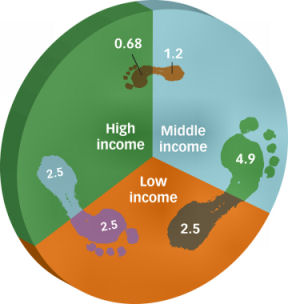Big Foot: Eco-footprints of rich dwarf poor nations’ debt
The first accounting of who’s stomping on whom finds rich nations leaving supersized boot prints of ecological damage on poor countries, adding up to more than those nations’ debt to the wealthier countries.

Rich nations’ doings during the last 4 decades of the 20th century caused up to $2.5 trillion in environmental impacts on poor countries, Thara Srinivasan of the Pacific Ecoinformatics and Computational Laboratory in Berkeley, Calif., and her colleagues estimate. Middle-income nations did about the same amount of damage to the low-income countries.
Each wallop is bigger than the total that poor countries have borrowed from wealthier nations. In 2000, that borrowing added up to $1.8 trillion. (All amounts are in 2005 international dollars, which are adjusted for purchasing power around the world.)
“This makes me wonder who owes who here,” says Jonathan Foley, who directs the Center for Sustainability and the Global Environment at the University of Wisconsin–Madison.
Environmental economists have experimented with ways to measure footprints of various activities since the 1990s, but Srinivasan says she doesn’t know of another attempt at a broad global accounting.
The team used the World Bank’s groupings of countries. Poor nations, with annual per capita income of $875 or less, included Bangladesh, India, and Nigeria, among others. Brazil, China, and the Russian Federation fall into the middling group. Income of $10,726 or more put such countries as Japan, the United States, and European nations into the rich group.
The researchers scoured the environmental literature for data on impacts. Workable information, from such sources as the United Nations and the United Kingdom’s Stern Review, turned up for six topics: climate change, ozone depletion, expanding agriculture, deforestation, overfishing, and the loss of mangrove swamps. Ecological damage included such miseries as the costs of health problems due to thinning ozone and storm damage along coasts no longer buffered by mangrove swamps. For ozone depletion and climate change, the researchers included impacts still to come (until 2100) of the activities in their 40-year study period.
Srinivasan laments the gaps in information that kept the analysis from toting up the ecological toll of other problems, such as pollution, invasive species, waterway modification, and war.
The team also looked at studies on which nations were driving particular environmental changes. For climate change, for example, the analysts calculated the proportion of greenhouse gases emitted by each of the nation groups. Seafood consumption measured the responsibility for overfishing.
The well-off disproportionately affected the poor for climate change, ozone depletion, and, less predictably, overfishing. “We were surprised,” says Srinivasan. The results appear this week online in the Proceedings of the National Academy of Sciences.
“The injustice inherent in the current environmental crisis may well exacerbate the divide between rich and poor,” says Boris Worm, a marine biologist at Dalhousie University in Halifax, Nova Scotia.






